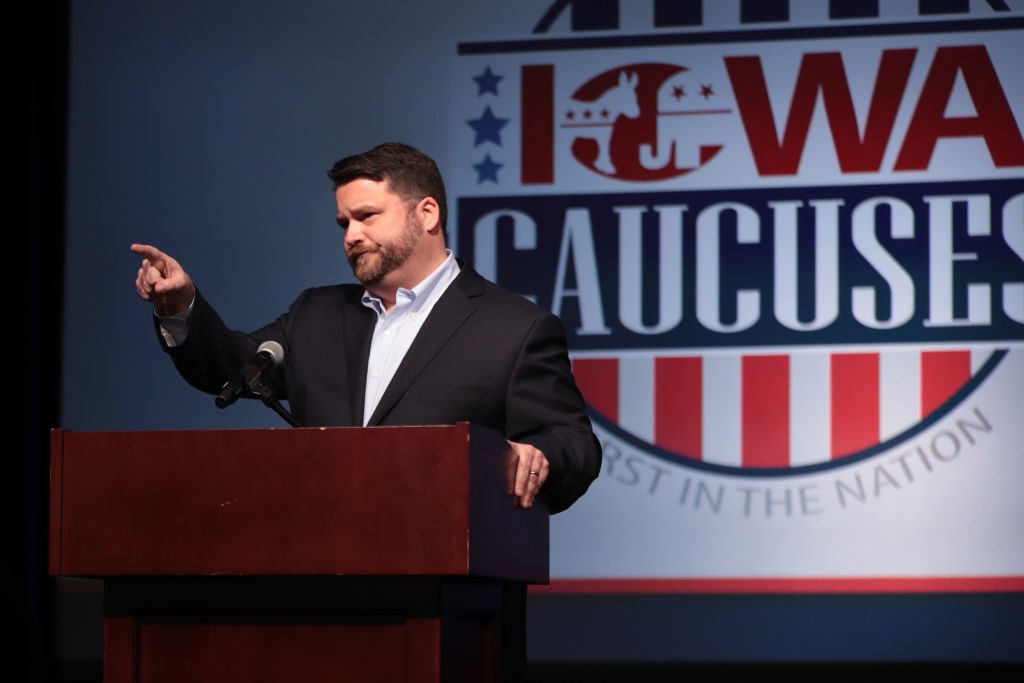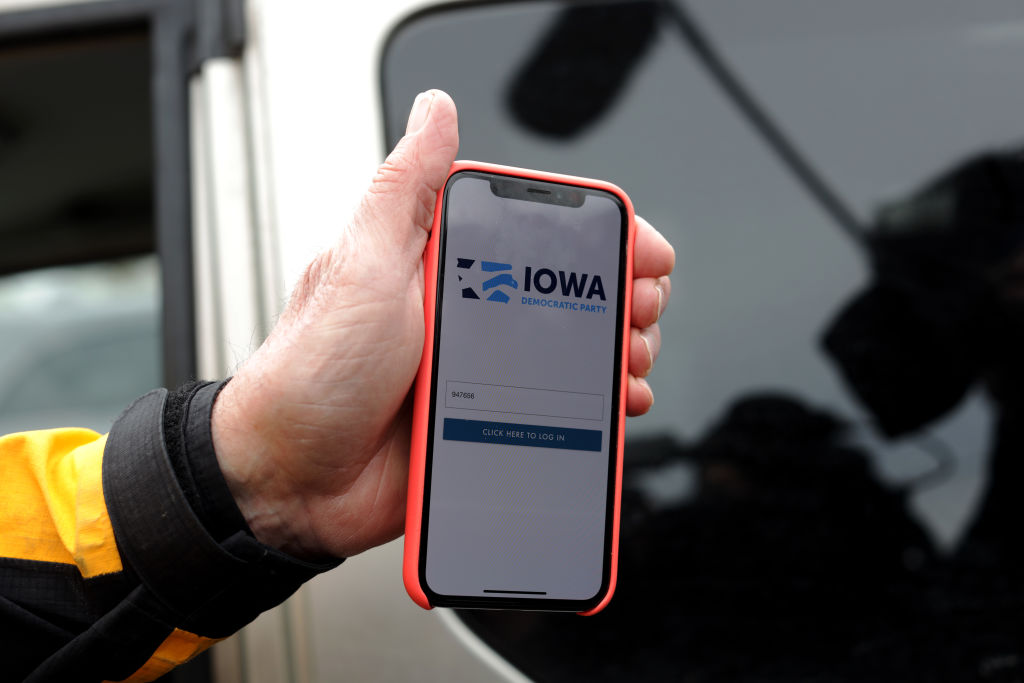Why Iowa’s 2020 caucus flop still haunts the civic tech world

A CNN broadcast at a 2020 Iowa Caucus watch party for Sen. Bernie Sanders notes ongoing delays of the results of the vote. Joe Raedle/Getty Images
The caucus stands as a model for how not to integrate tech into elections.
For Iowa Democrats and for makers of campaign and voting technology, there was the world as it existed before the 2020 Iowa caucuses and then there was the world after.
In the before times, Iowa was a major player in Democratic politics. It was a mecca for presidential hopefuls who flocked to diners and county fairs to practice retail politics in advance of the first-in-the-nation caucuses. Politically active Iowans could expect to meet and question multiple candidates during a competitive nominating cycle.
For civic technologists, it was a fraught but exciting time. There were perils to designing tech for campaigns and elections, but also great opportunities. Technology was viewed as a vital component that could make democracy more accessible or give a campaign an edge.
Then, a massive technological meltdown delayed caucus results for days and humiliated Iowa on the national stage. The vote reporting failure eroded trust in democratic processes when they were already under assault by then-President Donald Trump who repeatedly claimed without evidence that the 2020 contest would be rigged against him.
The meltdown was a gut punch for election officials, who had struggled since the 2016 contest was marred by foreign interference to convince the public that elections could be run safely and securely. Trump triumphantly called the caucus “an unmitigated disaster.” For technologists who wanted to make the campaign and election process run more smoothly and efficiently, the lesson was clear: There’s no longer any room for error.
“When you take what is at stake in politics and you couple that with technology that’s inherently imperfect, you get a very volatile mix,” said Eddie Perez, a board member at the OSET Institute, which seeks to increase public confidence in elections.
“You can draw a trajectory from Iowa in 2020 to today. Now, any maker of government and civic technology that is participating in a very public, forward-facing way in political power competitions does so at their own peril,” said Perez, who previously worked for 15 years in product management for Hart InterCivic, one of the three largest election technology vendors.
For Iowa Democrats, the outcome was, if anything, even more consequential.
Four years after the caucus app debacle, Iowa is an afterthought for national Democrats, another heartland state where the party was once competitive but that has been almost entirely ceded to Republicans now. The first-in-the-nation caucus, which had launched both parties’ presidential nominating contests dating back to the 1970s, is effectively no more, replaced by a write-in presidential preference contest that ends on Super Tuesday along with more than a dozen other states.
“I had coffee with Obama. I had coffee with Hillary. I met with Joe Biden when he was a senator so many times that we were almost on a first name basis. That’s all changed,” Bret Nilles, chair of the Linn County Democrats, home to Iowa’s second largest city Cedar Rapids, said.
This is one of the rare instances in which a public sector tech foul up had dramatic real world consequences that will endure for a generation or longer.

The app debacle is not the only reason that the national Democratic party bumped Iowa from its first-in-the-nation calendar spot. (The Republican nominating calendar still begins in Iowa). National Democrats had long viewed the caucus process as overly complex. The state, which is 85% white according to the 2020 Census, was viewed as insufficiently diverse. And President Joe Biden, who came in fourth in Iowa once all the votes were tallied, was a strong supporter of beginning the nominating calendar in South Carolina.
There also won’t be a truly competitive Democratic primary of any kind until at least 2028 and maybe not until 2032. Biden was not seriously challenged for the 2024 nomination and dropped out after winning a majority of delegates. If Vice President Kamala Harris, who replaced Biden on the ticket, wins in November and isn’t challenged for reelection, that will mean 12 years of incumbent Democratic candidates.
Yet, there’s a powerful sense in the state that the app debacle made it far easier for the national party to boot Iowa from the top calendar spot.
“Things were already moving in that direction, but the app failure was the straw that broke the camel’s back,” Bill Brauch, Democratic Party Chair for Polk County, which includes the state capital Des Moines, said.
Outsized impact
The app's failure didn't have to fundamentally alter the way national Democrats approached Iowa. But cascading tech problems collided with a growing public perception that election technology was vulnerable to outside forces.
First, the building process was rushed, hampered by external demands and it ignored many tech development best practices. Second, the meltdown happened in a political environment that was already bruised by unfounded claims of election chicanery by Trump and his allies.

One main pitfall was a series of late requests from the Democratic National Committee for new features and security testing, according to an independent audit commissioned by the Iowa Democratic Party. By the time the app was released to caucus leaders, there were just two weeks to go before caucus day, leaving little time for the rigorous testing that is vital for any technical product, especially one that will be used just once in a high-stakes event.
When a similar app was used by both Democrats and Republicans in the 2016 caucuses, by contrast, it was released months in advance to allow for extensive testing.
“Typically software isn’t used for just one night. You have the ability to soft launch something and learn from your mistakes. So, the only option when you don’t have that ability is to test the heck out of the thing,” said Rodney Guzman, former chief technology officer of InterKnowlogy, the firm that built the 2016 app as part of a contract with Microsoft.
Once the 2020 app arrived, it was overly complicated and difficult to download. Significantly, there wasn’t time to get it added to the Apple and Android app stores, so caucus leaders were asked to download it using a different and complicated method. One caucus chair described the process to The Washington Post: "You had to fill out a survey, which then got you a link, and then you had to download a different app, and enter in a code from your email, and then you would get the real app.”
These problems were magnified by the fact that many of the app’s prospective users were elderly and living in rural areas, often with spotty cell service.
“The app in 2020 felt like an afterthought,” said John Deeth, a longtime caucus precinct captain in Johnson county, which includes Iowa City. Deeth is also an election technician at the Johnson County auditor’s office.
Caucus leaders also kept details of the app secret, including the name of the company that built it, fearing that transparency would make it easier for hackers and foreign adversaries to compromise the process. That tactic, dubbed “security through obscurity” is generally frowned on by security experts.
Finally, the backup phone-in option for delivering caucus site results to the Iowa Democratic party was being managed by a human call center with just about 50 volunteers rather than a digital service that had been used in previous years. The call center was quickly overwhelmed by calls from caucus sites that couldn’t use the app. Things got worse when the phone-in number was shared by Trump supporters online. One volunteer told the Washington Post at the time that about a quarter of the calls he took were from Trump supporters.
Ultimately, auditors found that the caucus reporting app worked correctly when caucus leaders were able to use it. But a separate tool designed to share data with the DNC produced irregular results, which led the DNC to prevent Iowa Democrats from releasing results from the app that they feared would be tainted. It took days to do a hand count of paper ballots to audit the test results, frustrating the public and media who were laser focused on the contest and expected quick results.
The CEO of Shadow Inc., the Democrat-aligned company that built the 2020 app, did not respond to several interview requests. The Iowa Democratic Party also did not respond to an interview request.
Caucuses, as traditionally practiced by Iowa Democrats, differ substantially from primary elections. Instead of simply voting for their chosen candidate, caucus goers at roughly 2,000 locations across the state essentially organize and reorganize themselves into groups in an effort to maximize the number of state-level delegates for a series of preferred candidates. That means that any technology they use usually must be custom-built. Primaries, by contrast, work essentially like general elections and typically rely on the same voting systems that counties use for general election voting.
The aftermath
In the aftermath of the caucus night meltdown, there was a general reconsidering of what technology can do in an election context and what it can’t.
“The caucus app failure illustrates the stupidity of using technology just because people want to be modern,” said Douglas Jones, a retired computer science professor and elections expert at the University of Iowa and a former Democratic caucus precinct leader. He suggested a well-staffed call center would have done the job of receiving caucus night reports far more effectively.
“The standards of the app marketplace don't really prepare people to build apps that must work at scale during a two-hour period with no full-scale test beforehand,” Jones said.
“People who build software for space missions and military weapons systems can meet that kind of ‘failure-is-not-an-option’ requirement, but the price NASA and the military pay for that kind of software is extraordinarily high,” Jones added. “There's no way to afford that kind of price for an app used once every four years and likely to be obsolete in eight years.”
That soul searching was, in some ways, salutary. The months after the caucus brought a host of new challenges for election officials and the technologists that support them, including the onset of the coronavirus pandemic, a significant increase in voting by mail, a host of foreign disinformation campaigns related to elections and Trump and his allies doubling down on false claims that the election was stolen from him.
By and large, election systems withstood those challenges. But the distrust in voting systems sparked by the caucus debacle, remains a challenge.
“When you’re dealing with really consequential decisions like what candidates are going to win in a volatile political environment, there’s no margin for error,” Perez, the OSET Institute board member, said. “There’s been a degradation of trust in the reliability and accuracy of technology in government settings and that’s something the whole sector has had to contend with.”





